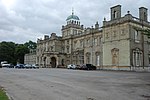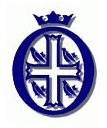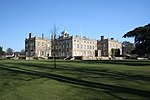Fornham All Saints

Fornham All Saints is a village and civil parish in Suffolk, England in the West Suffolk district. It is north-northwest of the town of Bury St Edmunds and 500m west of Fornham St Genevieve. Fornham All Saints is one of a trio of contiguous villages by the River Lark. The other villages are Fornham St Genevieve and Fornham St Martin. The village sign depicts a helmet and crossed swords commemorating two battles that took place here. In c902 King Edward the Elder fought off his cousin, Æthelwold ætheling, to retain the English crown. In 1173 Henry II defeated the Earl of Leicester and a Flemish army at the Battle of Fornham. Today the historic village is more peaceful. It appears on John Speed's 1610 map as "Fernham omnium Sanctorum". There's evidence of a small prehistoric or Roman settlement near Pigeon Lane, with as many as four hut circles. Prehistoric causeway and trenches on the river terrace remain only as cropmarks but were described by Suffolk County Council as "major Neolithic ritual monuments."The journalist and author Harold Begbie was born in Fornham, St. Martin, in 1871. The Three Kings pub, offering food and accommodation, is on the western outskirts of the village, at the junction of the A1101 and B1106. The church of All Saints, the parish church of Fornham All Saints, is a Grade I listed building. Surviving parts of the church from the twelfth to fifteenth centuries have been heavily restored during the Victorian period 1863-4. The south doorway dates from the twelfth century and the south porch from the fifteenth century. There is fifteenth century wood carving in the form of roof bosses and also 8 pairs of fifteenth century benches displaying animals on the armrests and a poppy head design. The south aisle roof is a nineteenth century restoration. There is a war memorial in the village in the form of a Latin cross of Portland stone. It commemorates the 13 people killed in the World Wars of the twentieth century. 12 people died in the First World War, and one died in the Second World War. The details of those who served in those two wars are to be found in the parish church Rolls of Honour displayed there. 74 village men served in the First World War; 33 men and 9 women served in the Second World War. The photographs and personal details of the war dead are displayed in the parish church's Debt of Honour Register.
Excerpt from the Wikipedia article Fornham All Saints (License: CC BY-SA 3.0, Authors, Images).Fornham All Saints
West Suffolk
Geographical coordinates (GPS) Address Nearby Places Show on map
Geographical coordinates (GPS)
| Latitude | Longitude |
|---|---|
| N 52.2767 ° | E 0.6915 ° |
Address
IP28 6JT West Suffolk
England, United Kingdom
Open on Google Maps









